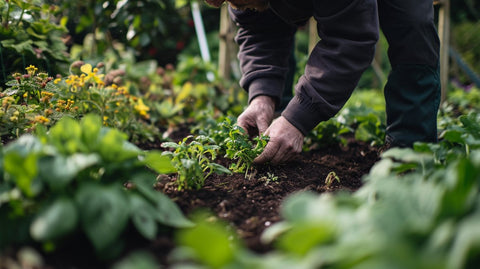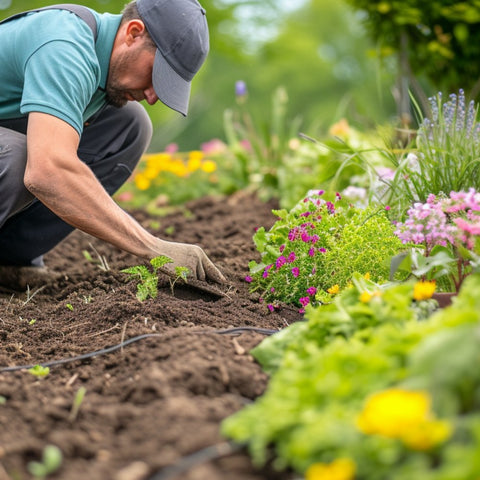weed control
Click here for more gardening tips and tricks!
Introduction
When it comes to maintaining a beautiful garden or farm, weed control plays a crucial role. Weeds not only compete with other plants for essential resources like nutrients, water, and space, but they can also have a negative impact on the overall health and growth of your plants. In this article, we will delve into the importance of weed control and explore various methods to effectively combat these intrusive plants.
What are weeds?
Before we dive deeper into the topic, let's first define what exactly weeds are. Weeds are essentially any plant that grows in an unwanted location, causing problems in the garden or farm. They are classified as invasive plants due to their ability to quickly spread and take over an area, often outcompeting desirable plants for resources.
There are various types of weeds, but some of the most common ones include dandelions, crabgrass, thistles, and bindweed. Each of these weeds poses specific challenges when it comes to control and eradication.
The effects of weeds on plants and gardens
The presence of weeds in your garden or farm can have detrimental effects on the overall health and growth of your plants. Here are some key ways that invasive plants can impact your garden:
1. Competition for nutrients, water, and space
Weeds compete with other plants for essential resources such as nutrients, water, and space. They have a remarkable ability to grow rapidly and aggressively, often overshadowing and depriving nearby plants of these vital elements. As a result, the growth and development of your desired plants can be significantly stunted.
2. Allelopathy and phytotoxicity
Some weeds possess allelopathic properties, which means they release chemicals into the environment that hinder the growth of other plants. These chemicals, known as allelochemicals, can inhibit seed germination and suppress the growth of neighboring plants. Additionally, certain weeds have phytotoxic effects, which can damage the tissues of surrounding plants, making them more susceptible to diseases and pests.
3. Reduced crop yields and plant growth
Weeds can significantly reduce the productivity of your garden or farm. Their ability to quickly spread and outcompete other plants can result in reduced crop yields and stunted plant growth. This can have economic implications for farmers and lead to disappointment for avid gardeners.
Methods of weed control
To effectively combat weeds, there are various methods of weed control that you can employ. Let's explore some of the most commonly used methods:
A. Cultural control
Cultural control involves implementing certain practices to prevent or minimize weed growth. Some effective cultural control methods include:
1. Crop rotation
Crop rotation involves alternating the types of crops you plant in a particular area over different seasons. This helps to prevent the buildup of specific weed populations. Different crops have different weed susceptibility, and by rotating crops, you can disrupt the life cycles of weeds and reduce their prevalence.
2. Mulching
Mulching is the practice of applying a layer of organic material, such as straw or wood chips, to the soil surface around your plants. This helps suppress weed growth by blocking sunlight, reducing the germination and growth of weed seeds. Additionally, mulch helps retain moisture in the soil, reducing the need for frequent watering.
3. Proper watering and fertilization
Ensuring your plants receive adequate water and nutrients is essential for their health and growth. By providing optimal conditions for your desired plants, you can help them compete against weeds more effectively. Weed seeds often thrive in nutrient-poor soils, so maintaining proper fertilization can also help reduce their growth.
B. Mechanical control
Mechanical control involves physically removing weeds from your garden or farm. This method can be labor-intensive but can be effective when done properly. Here are some mechanical control methods:
1. Hand-pulling
Hand-pulling weeds involves manually uprooting weeds from the soil. This method is most effective for small infestations or when dealing with weeds that have shallow roots. Make sure to remove the entire weed to prevent regrowth.
2. Mowing or cutting
For weeds that produce above-ground foliage, mowing or cutting can help control their spread. Regularly trimming the weeds can prevent them from setting seed and spreading further. However, this method may not work for weeds with deeply rooted systems.
3. Tilling or cultivating
Tilling or cultivating involves breaking up the soil to uproot weeds and expose their root systems. This method is effective for annual or shallow-rooted weeds. However, be cautious as excessive tilling can disrupt the soil structure and cause erosion.
C. Biological control
Biological control involves using living organisms to control weeds. This method is often used in agricultural settings and can be an environmentally friendly approach. Here are some biological control methods:
1. Introduction of natural enemies
Certain insects, fungi, or other organisms can be introduced into an infested area to feed on or attack specific weed species. These natural enemies can help reduce weed populations over time. However, employing this method requires careful research and consideration.
2. Use of beneficial insects or animals
Encouraging the presence of beneficial insects or animals, such as ladybugs or birds, can help control weed populations organically. These organisms often feed on weed seeds, larvae, or plant parts, helping to keep their growth in check.
D. Chemical control
Chemical control involves the use of herbicides to kill or inhibit weed growth. While this method can be highly effective, it should be used with caution to minimize negative impacts on the environment and desired plants. Here are some key points to consider:
1. Herbicides and their application methods
Herbicides come in various forms, including selective and non-selective options. Selective herbicides target specific weed types, while non-selective herbicides kill all plants they come into contact with. When using herbicides, always follow label instructions carefully to ensure safe and effective application.
2. Pre-emergent and post-emergent herbicides
Pre-emergent herbicides are applied before weed seeds germinate, while post-emergent herbicides are used on established weeds. Understanding the life cycle of the specific weeds in your garden can help determine the appropriate timing for herbicide application.
Organic and eco-friendly weed control methods
For those who prefer organic and eco-friendly approaches, there are alternative methods of weed control available. These methods minimize the use of synthetic chemicals and focus on natural means. Here are some organic weed control options:
A. Natural herbicides
Natural herbicides are derived from plant-based ingredients and are considered safer for the environment. These herbicides can be effective against certain weeds, but their efficacy may vary depending on the weed species and application method.
B. Homemade weed killers
Homemade weed killers are often made from household ingredients like vinegar, salt, or soap. While these DIY solutions can help control weeds, it's important to note that they may also affect desirable plants, so use them with caution and target them specifically to weed-infested areas.
C. Biodegradable weed barriers
Biodegradable weed barriers, such as geotextiles or cardboard, can be used to create physical barriers that prevent weed growth. These barriers are placed on the soil surface before planting and can help suppress weed emergence. Over time, they naturally break down, reducing their impact on the environment.
Best practices for effective weed control
While it's essential to stay vigilant in your efforts to combat weeds, here are some best practices to ensure effective weed control:
A. Regular inspection and early intervention
Regularly inspect your garden to identify weed seedlings or early signs of weed growth. By catching weeds early on, you can prevent them from establishing and spreading. Prompt intervention is key to effective weed control.
B. Proper timing for weed removal
Understanding the life cycle and growth habits of the weeds in your garden can help you determine the best time to remove them. Some weeds are easier to uproot or control during specific stages of their growth cycle. Take advantage of this knowledge to optimize your weed control efforts.
C. Correct handling and disposal of weeds
When removing weeds, ensure that you dispose of them properly to prevent them from re-infesting the area. Avoid composting weeds with mature seeds, as they can easily spread during the composting process. Instead, dispose of them in bags or burn them, depending on local regulations.
D. Maintenance and prevention strategies
Regular garden maintenance, including proper watering, fertilization, and mulching, can help prevent weed growth. A well-maintained garden with robust plants is more resilient against weed infestations. Additionally, employing preventive measures, such as using weed barriers or plant spacing, can further reduce the likelihood of weed establishment.
Conclusion
In conclusion, weed control is crucial for maintaining the health and productivity of your garden or farm. Weeds can have a negative impact on plants by competing for resources, releasing harmful chemicals, and reducing crop yields. By implementing various methods of weed control, including cultural, mechanical, biological, and chemical approaches, you can effectively combat these unwanted plants.
Whether you prefer organic or conventional methods, there are options available to suit your specific needs and preferences. Remember to stay proactive, employ best practices, and adapt your weed control strategies based on the unique characteristics of your garden. With proper weed control, you can create an environment where your desired plants thrive, free from the interference of invasive weeds.
Do you need more tips and tricks for a beautiful garden? Click here to discover more!






























Comments (0)
There are no comments for this article. Be the first one to leave a message!